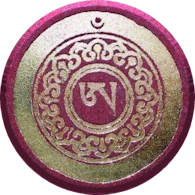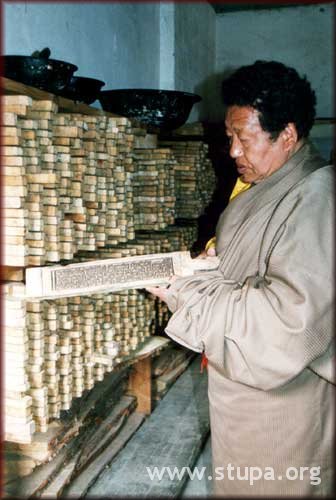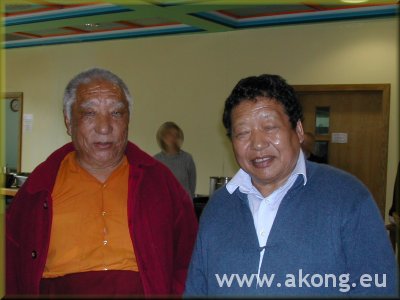
Akong Rinpoché Establishing Buddha-Dharma
Part Nine: Dharma Teachings ... beginning the task
Buddhadharma exists mainly as concepts and practices. The conceptual content is classified in various ways:
![]() 1. In the Southern Buddhist traditions as the three collections (Tripitaka) of sutra, vinaya and abhidharma and as the various shastra written by subsequent great Buddhist masters explaining these.
1. In the Southern Buddhist traditions as the three collections (Tripitaka) of sutra, vinaya and abhidharma and as the various shastra written by subsequent great Buddhist masters explaining these.
![]() 2. In the Northern Buddhist traditions also as the three collections but recognising the Mahayana sutras as also part of the Buddha’s teachings and including the shastras of the great Mahayana masters, such as Nagarjuna, Asanga, Shantideva and so forth.
2. In the Northern Buddhist traditions also as the three collections but recognising the Mahayana sutras as also part of the Buddha’s teachings and including the shastras of the great Mahayana masters, such as Nagarjuna, Asanga, Shantideva and so forth.
![]() 3. In the Tibetan tradition (mainly but not uniquely) including a fourth collection, that of the tantras.
3. In the Tibetan tradition (mainly but not uniquely) including a fourth collection, that of the tantras.
 In Tibet, the teachings of buddhadharma were principally transmitted through the monastic colleges, known as shedra. Each major tradition developed its own body of literature of these theoretical teachings and these became the defining criteria of the various shades of belief and understanding held by each school and sub-school. With the intention of Samye Ling eventually having its
own shedra, in the long term, Akong Rinpoché wanted to lay the best foundations of study and consulted with the XVIth Karmapa, Khenchen the IXth Thrangu Rinpoché and the Very Venerable Kalu Rinpoché concerning which texts should be taught first, in the shorter term, whenever the opportunity for proper studies was in place at Samye Ling. Their answers concurred and can be resumed as follows:
In Tibet, the teachings of buddhadharma were principally transmitted through the monastic colleges, known as shedra. Each major tradition developed its own body of literature of these theoretical teachings and these became the defining criteria of the various shades of belief and understanding held by each school and sub-school. With the intention of Samye Ling eventually having its
own shedra, in the long term, Akong Rinpoché wanted to lay the best foundations of study and consulted with the XVIth Karmapa, Khenchen the IXth Thrangu Rinpoché and the Very Venerable Kalu Rinpoché concerning which texts should be taught first, in the shorter term, whenever the opportunity for proper studies was in place at Samye Ling. Their answers concurred and can be resumed as follows:
• Two of the four famous Kagyu study texts: Gampopa’s Ornament of Precious Liberation, a textbook outlining the main principles of dharma, and Maitreya/Asanga’s Mahayana Uttara Tantra Shastra (“Jut Lama”), a specialist but very important work on buddha-nature, vital as a basis for understanding tantra.
• Other major Mahayana texts outlining the ways of the bodhisattva: Shantideva’s Entering the Bodhisattva Conduct, Atisha’s Mind Training and Ngulchu Tomay’s 37 Practices of the Bodhisattva, being the main ones.
• Works making clear the Mahamudra view: the Mahamudra Prayer of the IIIrd Karmapa and its commentaries; the IXth Karmapa’s Distinguishing Consciousness from Primordial Wisdom and Pointing Out the Essence of the Tathagata; the Kagyu dohas and Jamphel Bengar Zangpo’s Short Prayer to Vajradhara.
• A good resumé of the abhidharma teachings: the preference was for Mipham Rinpoché’s Entering the Ways of the Wise, for which Khenchen Thrangu Rinpoché had an exceptional transmission from the author, who composed much of it at Thrangu monastery.
• Lineage hagiographies, especially those of Tilopa, Naropa, Marpa, Milarepa and Gampopa, as well as those of the Karmapas.
• (With time, when people had a better dharma grounding) teachings on the Prajnaparamita and Middle Way (Mahayana and Kagyu versions).
Of these, the first two texts (Gampopa and Asanga) were said, by these great masters, to be the most vital. Akong Rinpoché sometimes quoted something the Very Venerable Kalu Rinpoché had told him in this respect:
“Even if someone is going to spend their whole life in meditation in a cave, they must know Gampopa’s Tarjen and Asanga’s Jut Lama. Otherwise all the time and effort to meditate may be of little use.”
 Thus, once the connection had been made with Khenpo Tsultrim Gyamtso during the second Karmapa tour, the author and Katia were set to intensive work with Khenpo-la and Acharya Tenpa, going through these texts several times in a very thorough way with a view to making translations and mastering their content, according to the expressed wish of the Karmapa. Subsequently,
as Khenpo Tsultrim and Khenchen Thrangu Rinpoché taught in Samye Ling, these two texts and the other texts mentioned above were presented there, in their entirety, as the main tools for dharma study in our tradition.
Thus, once the connection had been made with Khenpo Tsultrim Gyamtso during the second Karmapa tour, the author and Katia were set to intensive work with Khenpo-la and Acharya Tenpa, going through these texts several times in a very thorough way with a view to making translations and mastering their content, according to the expressed wish of the Karmapa. Subsequently,
as Khenpo Tsultrim and Khenchen Thrangu Rinpoché taught in Samye Ling, these two texts and the other texts mentioned above were presented there, in their entirety, as the main tools for dharma study in our tradition.
.....this narrative continues here: Getting the Right Teachers
